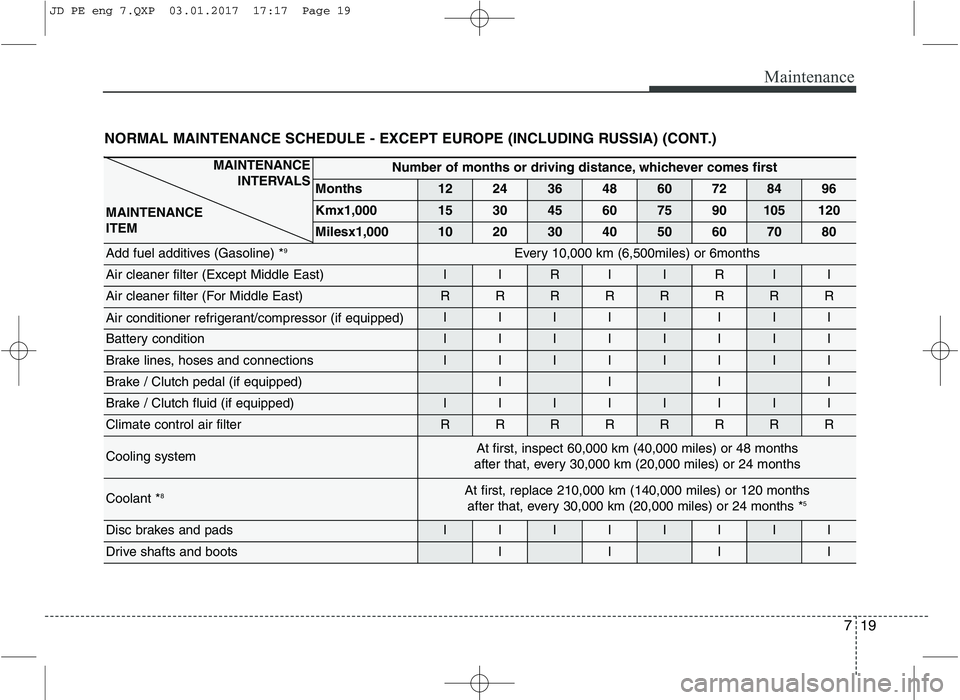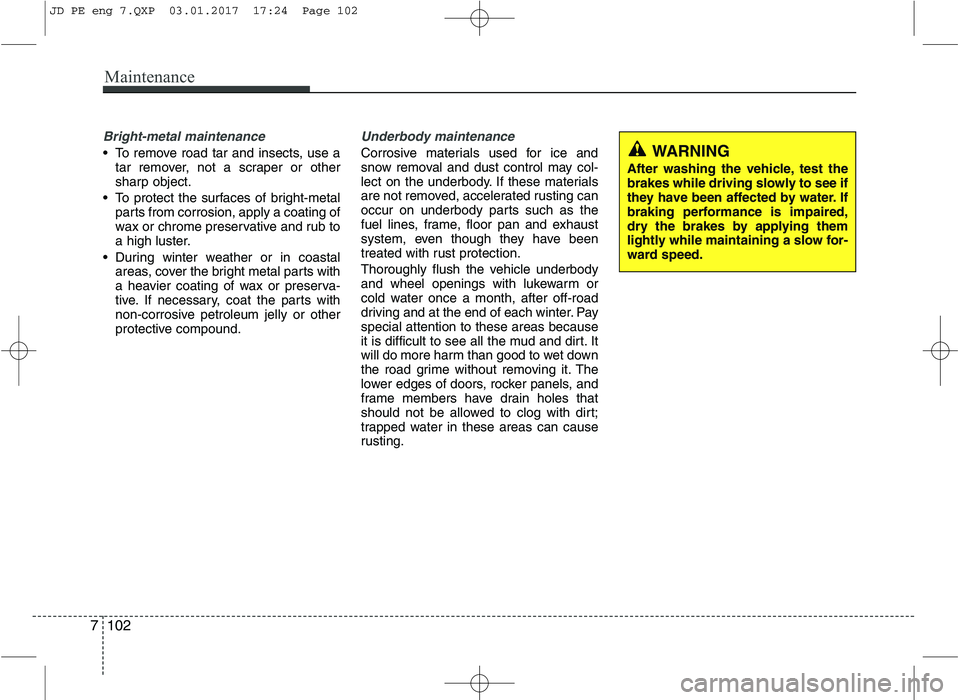2017 KIA CEED brakes
[x] Cancel search: brakesPage 537 of 653

719
Maintenance
NORMAL MAINTENANCE SCHEDULE - EXCEPT EUROPE (INCLUDING RUSSIA) (CONT.)
MAINTENANCE INTERVALS
MAINTENANCE ITEM Number of months or driving distance, whichever comes first
Months
122436 4860 7284 96
Kmx1,000
153045 6075 90105 120
Milesx1,000
102030 4050 6070 80
Add fuel additives (Gasoline) * 9Every 10,000 km (6,500miles) or 6months
Air cleaner filter (Except Middle East)IIRIIRII
Air cleaner filter (For Middle East)RRRRRRRR
Air conditioner refrigerant/compressor (if equipped)IIIIIIII
Battery conditionIIIIIIII
Brake lines, hoses and connectionsIIIIIIII
Brake / Clutch pedal (if equipped)IIII
Brake / Clutch fluid (if equipped)IIIIIIII
Climate control air filterRRRRRRRR
Cooling systemAt first, inspect 60,000 km (40,000 miles) or 48 months
after that, every 30,000 km (20,000 miles) or 24 months
Coolant * 8At first, replace 210,000 km (140,000 miles) or 120 months
after that, every 30,000 km (20,000 miles) or 24 months * 5
Disc brakes and padsIIIIIIII
Drive shafts and bootsIIII
JD PE eng 7.QXP 03.01.2017 17:17 Page 19
Page 541 of 653

723
Maintenance
SEVERE DRIVING CONDITIONS
A : Repeated short distance driving
B : Extensive idling
C : Driving in dusty, rough roads
D : Driving in areas using salt or other corrosive materials or in very cold weather
E : Driving in heavy dust condition
F : Driving in heavy traffic area. G : Driving in mountainous areas.
H : Towing a trailer or using a camper on roof rack
I : Driving for patrol car, taxi, commercial car or vehicle tow-
ing
J : Driving over 170 km/h (106 mile/h)
K : Frequently driving in stop-and-go conditions
L : Driving in very cold weather
Maintenance itemMaintenance operationMaintenance intervalsDriving condition
Front suspension ball jointsIInspect more frequently
depending on the conditionC, D, E, F, G
Disc brakes and pads, calipers and rotorsIInspect more frequently
depending on the conditionC, D, E, G, H
Parking brake (Hand type)IInspect more frequently
depending on the conditionC, D, G, H
Driveshaft and bootsIInspect more frequently
depending on the conditionC, D, E, F, G, H, I, J
Climate control air filterRReplace more frequently
depending on the conditionC, E, G
JD PE eng 7.QXP 03.01.2017 17:17 Page 23
Page 618 of 653

Maintenance
100
7
APPEARANCE CARE
Exterior care
Exterior general caution
It is very important to follow the label
directions when using any chemical clean-
er or polish. Read all warning and cautionstatements that appear on the label.
Finish maintenance
Washing
To help protect your vehicle’s finish from
rust and deterioration, wash it thoroughlyand frequently at least once a month with
lukewarm or cold water.
If you use your vehicle for off-road driv-
ing, you should wash it after each off-
road trip. Pay special attention to the
removal of any accumulation of salt, dirt,
mud, and other foreign materials. Ensure
drain holes in the lower edges of the
doors and rocker panels are kept clean.
Insects, tar, tree sap, bird droppings,
industrial pollution and similar deposits
can damage your vehicle’s finish if not
removed immediately.
Even prompt washing with plain water may
not completely remove all these deposits.
A mild soap, safe for use on painted sur-
faces, may be used.
After washing, rinse the vehicle thor-
oughly with lukewarm or cold water. Do
not allow soap to dry on the finish. High-pressure washing
When using the High Pressure car wash
system for cleaning the exterior of your
vehicle, be aware that without following
the proper precautions, it may damage
your car.
Never let the high pressure car wash
nozzle come too close to the windows,
soft materials, light system (headlights,
taillights and such), camera, sensors,
bumpers, rubber (including tires), and
also the underside of the vehicle.
The high pressure could damage these parts especially if injected from a
short distance.
Never clean a specific point on the
vehicle for a prolonged time. Applying
the high pressure car wash nozzle fora prolonged time it could damage and
harm the vehicle.
Even while the high pressure car wash nozzle is applied from a distance for a
limited time only, always bear in mind
that a direct stream would greatly
affect the surface of the vehicle.
Always use high pressure car washes which supply jet spray nozzle system,not direct stream nozzle system
WARNING - Wet brakes
After washing the vehicle, test the
brakes while driving slowly to see if
they have been affected by water. If
braking performance is impaired,
dry the brakes by applying them
lightly while maintaining a slow for-
ward speed.
CAUTION
Do not use strong soap, chemical detergents or hot water, and donot wash the vehicle in directsunlight or when the body of the
vehicle is warm.
Be careful when washing the side windows of your vehicle.Especially, with high-pressurewater, water may leak through the
windows and wet the interior.
To prevent damage to the plastic parts and lamps, do not cleanwith chemical solvents or strongdetergents.
JD PE eng 7.QXP 03.01.2017 17:24 Page 100
Page 620 of 653

Maintenance
102
7
Bright-metal maintenance
To remove road tar and insects, use a
tar remover, not a scraper or other
sharp object.
To protect the surfaces of bright-metal parts from corrosion, apply a coating of
wax or chrome preservative and rub to
a high luster.
During winter weather or in coastal areas, cover the bright metal parts with
a heavier coating of wax or preserva-
tive. If necessary, coat the parts with
non-corrosive petroleum jelly or other
protective compound.
Underbody maintenance
Corrosive materials used for ice and
snow removal and dust control may col-
lect on the underbody. If these materials
are not removed, accelerated rusting can
occur on underbody parts such as the
fuel lines, frame, floor pan and exhaust
system, even though they have been
treated with rust protection.
Thoroughly flush the vehicle underbody
and wheel openings with lukewarm or
cold water once a month, after off-road
driving and at the end of each winter. Payspecial attention to these areas because
it is difficult to see all the mud and dirt. It
will do more harm than good to wet down
the road grime without removing it. The
lower edges of doors, rocker panels, and
frame members have drain holes that
should not be allowed to clog with dirt;
trapped water in these areas can cause
rusting.WARNING
After washing the vehicle, test the
brakes while driving slowly to see if
they have been affected by water. If
braking performance is impaired,
dry the brakes by applying them
lightly while maintaining a slow for-
ward speed.
JD PE eng 7.QXP 03.01.2017 17:24 Page 102
Page 646 of 653

I3
Index
Brake system..................................................................5-40
Anti-lock brake system (ABS)....................................5-48
Electric parking brake (EPB) ......................................5-44
Electronic stability control (ESC) ..............................5-51
Emergency Stop Signal (ESS) ....................................5-56
Good braking practices ..............................................5-56
Hill-start assist control (HAC) ....................................5-55
Parking brake - Hand type ..........................................5-42
Power brakes ..............................................................5-40
Vehicle stability management (VSM) ........................5-54
Brake/clutch fluid ..........................................................7-32 Checking the brake fluid level ....................................7-32
Bulb wattage ....................................................................8-6
Child restraint system ....................................................3-32 Using a child restraint system ....................................3-34
Clean air ......................................................................4-163
Climate control air filter ................................................7-37 Filter inspection ..........................................................7-37
Filter replacement ......................................................7-37
Cruise Control system ..................................................5-58
Declaration of conformity ............................................8-15 Defroster ......................................................................4-139
Rear window defroster ..............................................4-139
Dimensions ......................................................................8-2
Door locks......................................................................4-17 Child-protector rear door lock ....................................4-21
Deadlocks....................................................................4-20
Door lock/unlock features ..........................................4-20
From inside ................................................................4-18
From outside ..............................................................4-17
Dual Clutch Transmission (DCT)..................................5-30 Dual clutch transmission operation ............................5-30
Good driving practices ................................................5-37
Economical operation ....................................................5-81
Emergency commodity ..................................................6-40 Fire extinguisher ........................................................6-40
First aid kit ..................................................................6-40
Tire pressure gauge ....................................................6-40
Triangle reflector ........................................................6-40
Emergency starting ..........................................................6-5 Jump starting ................................................................6-5
Push-starting ................................................................6-7
Emission control system ..............................................7-107
Engine ..............................................................................8-3
Engine compartment ................................................2-6, 7-3
C
D
E
Page 652 of 653

I9
Index
Tailgate ..........................................................................4-22
Closing the tailgate ....................................................4-22
Emergency tailgate safety release ..............................4-23
Opening the tailgate ....................................................4-22
Theft-alarm system ........................................................4-14 Armed stage ................................................................4-14
Disarmed stage ............................................................4-16
Theft-alarm stage ........................................................4-15
Tire Pressure Monitoring System (TPMS) ....................6-30 Changing a tire with TPMS ........................................6-33
Tire specification and pressure label ............................8-14
Tires and wheels ....................................................7-45, 8-8 Checking tire inflation pressure ..................................7-47
Low aspect ratio tire ..................................................7-55
Recommended cold tire inflation pressures................7-45
Tire care ......................................................................7-45
Tire maintenance ........................................................7-51
Tire replacement ........................................................7-49
Tire rotation ................................................................7-48
Tire sidewall labeling..................................................7-51
Tire traction ................................................................7-51
Wheel alignment and tire balance ..............................7-49
Wheel replacement ....................................................7-51 Towing ..........................................................................6-36
Emergency towing ......................................................6-37
Removable towing hook ............................................6-37
Towing service ............................................................6-36
Trailer Towing ..............................................................5-90 Driving with a trailer ..................................................5-92
Hitches ........................................................................5-91
If you do decide to pull a trailer ................................5-97
Maintenance when trailer towing ..............................5-96
Safety chains ..............................................................5-92
Trailer brakes ..............................................................5-92
Vehicle break-in process ..................................................1-5
Vehicle certification label ..............................................8-13
Vehicle identification number (VIN) ............................8-13
Vehicle weight ............................................................5-100 Base curb weight ......................................................5-100
Cargo weight ............................................................5-100
GAW (Gross axle weight) ........................................5-100
GAWR (Gross axle weight rating) ..........................5-100
GVW (Gross vehicle weight) ..................................5-100
GVWR (Gross vehicle weight rating) ......................5-100
Overloading ..............................................................5-100
Vehicle curb weight ..................................................5-100
T
V